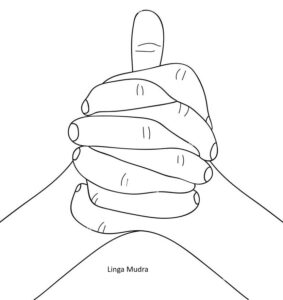Linga Mudra
Introduction
Linga Mudra is a powerful hand gesture in yoga and Ayurveda that symbolizes the union of masculine and feminine energies and represents Lord Shiva (the cosmic masculine principle). It is considered a heating mudra, often practiced to boost vitality, inner strength, immunity, and energy. This mudra harnesses the fire element (Agni Tattva) and is especially recommended during cold weather, low energy states, or conditions where increased metabolic activity is beneficial.
Meaning
Linga in Sanskrit means phallus, symbol of Shiva, and creative cosmic energy.
This mudra represents heat, power, and transformation.
It is also called the Mudra of Heat as it generates internal warmth and enhances the fire element.
How to Perform (Practice)
Sit comfortably in a meditative posture (Padmasana, Sukhasana, or Vajrasana). Keep the spine erect.
Interlock the fingers of both hands, palms pressed together.
Keep the left thumb upright, encircled by the right thumb and right index finger.
Relax the shoulders and keep the hands near the chest or in the lap.
Close the eyes and breathe deeply and slowly.
Focus on the sensations of warmth and energy building within.
Benefits
Physical Benefits
Increases body heat, useful in cold weather.
Boosts immunity and strengthens defense against infections.
Helpful in colds, cough, asthma, bronchitis, and sinus issues.
Stimulates digestion and metabolism.
Promotes weight loss by enhancing fat metabolism.
Mental & Emotional Benefits
Increases confidence and willpower.
Reduces lethargy and depression.
Enhances inner strength, motivation, and enthusiasm.
Spiritual Benefits
Awakens inner energy (Agni/Tejas).
Symbolizes devotion to Lord Shiva, bringing balance of masculine energy.
Encourages transformation and purification.
Contraindications
Avoid in hot weather or when body heat is already high.
Not suitable for people with fever, hypertension, gastritis, ulcers, hyperthyroidism, or excessive Pitta dosha.
Should not be practiced for long durations without guidance.
Pregnant women should avoid prolonged practice.
Anatomy & Physiology
Elemental Association: Fire (Agni Tattva).
Physiological Impact:
Stimulates sympathetic nervous system.
Increases blood circulation and metabolic rate.
Enhances heat production (thermogenesis).
Supports respiratory system by dilating air passages.
Kinesiology
Involves isometric contraction of hand muscles by interlocking fingers.
Provides stabilization and balance in hand muscles, particularly the flexors and extensors.
Helps activate meridians (energy channels) linked with lung and digestive organs.
Neurology
Stimulates the hypothalamus, regulating body temperature and metabolic processes.
Activates parasympathetic tone initially, then enhances sympathetic drive for energy mobilization.
Influences the limbic system, creating motivation and emotional strength.
Duration of Practice
Practice 15–20 minutes daily, preferably in three short sessions (5–7 minutes each).
Avoid overdoing as it can create excess heat and imbalance.
Counter Mudra
To balance the heat of Linga Mudra, practice:
Varun Mudra (for water element & cooling).
Prana Mudra (restores vitality).
Chin Mudra (for relaxation).
Conclusion
Linga Mudra is a highly energizing and heat-generating mudra that enhances inner strength, immunity, and metabolism. Rooted in the symbolism of Lord Shiva, it transforms lethargy into vitality. However, it must be practiced with caution, especially for those prone to excess heat, high blood pressure, or Pitta imbalance. Balanced practice, awareness, and complementary cooling mudras ensure its safe and effective application.
FAQ
Q1. Can Linga Mudra help in weight loss?
Yes, it boosts metabolism and aids fat burning when combined with yoga and diet.
Q2. Can I practice Linga Mudra daily?
Yes, but limit to 15–20 minutes to avoid overheating.
Q3. Does it cure asthma and respiratory issues?
It helps in relieving congestion and improving breathing but should not replace medical treatment.
Q4. When should I avoid Linga Mudra?
Avoid during fever, hot climate, high blood pressure, or hyperacidity.
Q5. Can children practice this mudra?
Yes, for short durations (5–7 minutes), especially in winter under guidance.
References
Hirschi, Gertrud. Mudras: Yoga in Your Hands.
K. S. Joshi. Mudras in Yoga.
Ayurveda & Yoga texts on therapeutic mudras.
Research articles on hand mudras and their effects on autonomic functions.

